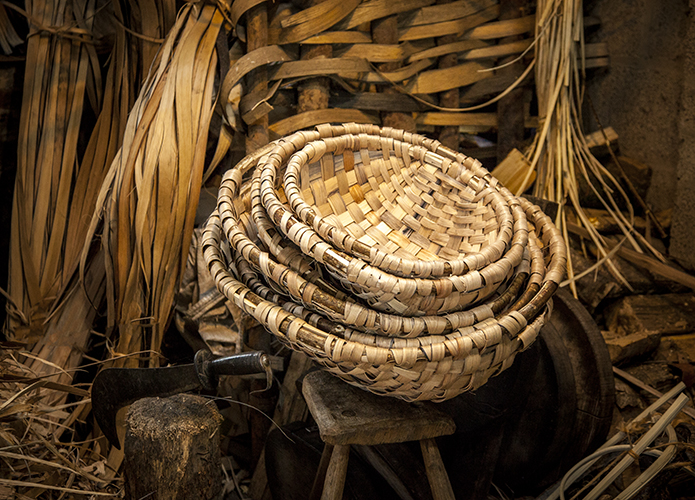
Working wood from a stem of green oak up to 8 inches diameter into a strip of the very same piece of oak only 1/16th inch in thickness takes both craftsmanship and commitment; attributes Owen Jones has baskets of. The highly skilled and time-consuming process of broad-leaved basketry is a labour of love and Owen Jones, the last full-time oak swill basket maker, based in the Southern Lake District, takes us through the procedures of splitting, boiling, throwing, riving, bundling, dressing and weaving, all hand and foot (& knee) operated techniques that keep this ancient craft traditional and true. Let’s find out how this centuries-old creative craft continues in modern-day Lakeland, as Owen, in his own words, describes the process of making a Cumbrian oak swill basket…
MATERIALS
Swills are made from weaving things strips of oak around oval-shaped hazel rim (or “bool”). That’s not to say other types of wood couldn’t be used, as if I lived in Kent, then no doubt I could use sweet chestnut instead of oak, but these are the types of wood that are abundant up here.
The quality of wood used is really important; the best swill wood is straight, knot-free, and from the butt end (i.e. the first 8-10 feet of the tree) rather than higher up. This type of wood splits, or rives, cleanly. However, the supply of material is very variable, and you never really know what it will be like from its outward appearance – some wood could be coarse or hard inside, and others could be knotty and twisted. I find there’s an undulating wave of joy and despair when examining wood for the first time.
Obtaining Good Oak
The oak I use is mostly coppiced oak, meaning it derives from one of a number of stems emerging from a single stool, possibly in the region of 20-30 years’ old, which is harvested on a regular cycle. The diameter of this wood is approximately 4-6 inches thick, although it can be as much as 8 inches. Maiden trees (i.e. those that have grown from a seed, rather than a stool) can be used, but they tend not to grow as straight as coppiced oak, although the more mature the oak tree is, the straighter the oak tends to be, as most of the knots formed when the tree was young become dead knots in the heart, and I tend not to use the heartwood from large diameter trees. Coppice-grown wood grows straighter as the established root systems allows the oak stems to grow vigorously, and due to competition from surrounding trees, the trunks are drawn up to the light and therefore tend to grow vertically. The same thing applies to non-coppice-grown oak in valleys.
The hazel I use for the bools are also coppiced. I use straight rods that are one inch in diameter consistently along the length, rather than tapered, and always use the butt end, rather than from higher up the rod. I enjoy cutting material, whether oak or hazel, and I find it very physically satisfying.
PREPARATION
Once I’ve obtained some good, straight lengths of oak, ideally 8-10 feet long, the first preparatory step is to cut them down into shorter lengths (or billets) of between two foot and five foot six inches to make the thicker ribs (or spelks, which are pronounced ‘spells’ in Cumbrian dialect) and the longer, finer weavers (or ‘taws’, which are pronounced ‘tars’ in the same dialect). The preferred wood for making the taws is definitely at the butt end of the stem.
Cleaving the Oak
The oak billets are split down lengthwise with the grain using a lathaxe (also known as a ‘froe’, commonly used for making plaster laths), and the heart wood is cut out, as this is not used in swill-making. The wood is stood upright (with the butt end closest to the floor) and the blade of the lathaxe is placed in the middle of the top, which it is struck by a knocker, made from off-cuts of oak, and driven through the length, all the way to a few inches above the bottom.
The lathaxe is then twisted to cleave the oak apart.
The split wood can be split lengthwise once or twice more depending on the original thickness (the thicker it is, the more splits will be needed lengthwise, so quartered, cleft into six, or cleft into eight billets). What we’re looking for is four piles of billets in equal quantities: short and long spelks, and short and long taw.
Boiling the Oak
Once the billets have been cleft into quarters, sixths or eighths, they are then boiled in water for several hours which softens the resins allowing for wood fibres to be separated more easily, so we can then begin tearing or “riving” them into strips. Taws are placed at the bottom of the boiler with spelks above them, and these are held under water by heavy logs placed on top of them. A fire is lit under the boiler and after an hour the water comes to a rolling boil which continues for 3 or 4 hours, although it’s necessary to check the water levels, as steam loss is quite significant.
A swill boiler is between 10-11 feet in length, 20 inches wide, and 16 inches deep. It includes a cast iron trough – the boiler – set up 20 inches off the floor, with fire bricks either side, and cast-iron fire bars underneath, above which shavings and offcuts are burned to heat up the boiler. The boiler has lids, which can be either hinged or loose-fitted, to speed the boil and retain the heat and reduce water loss through steam, and there is a flue fixed at one end with a flue leading to a chimney.
MAKING THE HAZEL BOOL
The bool, or oval rim of the basket, that the oak strips are woven into, is made whilst the billets are being boiled. The length of the bool varies depending on the size of the swill; for instance, a 22-inch diameter swill requires of 6’ 4” long length of coppiced hazel rod, about an inch in thickness, ideally with a little taper.
The best hazel is clean and straight, and preferably cut as close to the butt of the hazel coppice tree as possible. We place the hazel rod against a measurement (or “story”) stick which has four notches cut into it at different lengths for marking out timber and measuring different component parts of the swill, including a short spelk, long spelk, short taw, long taw, and the overall length would be the length of the bool (I make mine from the butt ends of thin hazel offcuts).
Dressing the bool
The hazel is dressed, by shaving a skim off the surface on one edge to create an inside edge to the bool, and shaving a splice off each end of the bool on opposite sides, to enable the tapered ends of the bool to be joined together once it is formed into an oval shape.
Steaming the bool
Once the bool has been dressed it is placed in the boiler for steaming. The bool is placed on top of the logs that are weighing down the taws and spelks being boiled, ensuring that the bool is above the water level and being steamed, and not immersed in water, otherwise it will get too soft. Twenty minutes of steaming is generally enough. I generally put up to 20 bools in at a time as it is more time efficient.
Once retrieved hot from the boiler, the bool is thrown onto a hard floor to remove any excess moisture. A trained ear will tell me whether the bool is too soft or hard based on the noise it makes from hitting the floor.
Bool bending
The bool is then placed around an oval block of wood called a bool bender or ‘former’ to create the desired shape of the rim. The butt end of the steamed hazel wand is placed under a hook fixed to the former, and then the skimmed side of the bool is pulled into contact with the block, rotating around it, keeping a firm pressure to ensure it doesn’t loosen.
Once bending is complete, the two splice ends should meet together, and two 1.5 inch nails are then driven in at an angle, and the ends of the nails are clenched over to ensure the join holds fast. Whilst the bool is still soft, any adjustments to shape can be made on a “set horse” by applying pressure, such as creating a dishing shape. Once set into shape, any sharp edges can be used by dressing the bool fixed to a swillers mare (essentially, a wooden foot vice) with a draw knife.
RIVING THE OAK
Preparation
The oak spelks and taws need to be riven when they are hot, so when the wood is pulled from the water after boiling, it’s necessary to tie towels around your knees (between which the wood is held in place) to protect the inside of knees from hot oak.
The spelks are riven first, as the taws benefit from the extra boiling. When riving, it’s important that only one piece of wood is taken out of the boiling water at a time, as the others will cool down too quickly – if that happens, it’s not the end of the world, as the wood can be put back in the boiler for a few minutes. Once a piece of oak is extracted from the water, it is immediately thrown onto the floor to remove any excess water. Any bark on the wood usually flakes off at this point, and you’re left with a lovely sweet smell of oak from the inner surface of the bark.
Riving the Spelks
What we’re looking to achieve here is thinning the billets into spelks that will form the ribs of the basket (once dressed), and these need to be thinned (riven) to approximately 1/8th of an inch thick. This procedure is normally done sitting on a long bench or “stool” using a blunt but heavy splitting/riving knife to half the billets, and a lighter, but still blunt, riving knife for further riving to until the wood is thin and malleable.
Sitting on the stool, the spelk billet is gripped vertically between your knees, with the butt of the billet firmly on the floor, so that the heavy riving knife can be placed on the top of the billet, centred, and driven down with a knocker several inches into the wood, enough to get your hands into the split to hold both pieces and pull apart, ensuring the split is running evenly.
Once the billet has been halved, it’s necessary to repeat the process, but using the smaller riving knife and knocker. It’s important that the top and bottom edges are clean, rather than frayed, so one firm blow is best, driving the knife down into the wood about an inch, where it will be possible to get your thumbs into the split to pull it apart.
Whilst I’ve said the spelks need to be riven to about an eighth of an inch, this is only an approximate measurement, as it’s more about ‘feel’ than an exact science. As the spelks are the ribs of the basket, they need to be bent into a curved shape and attached to the bool, so there needs to be enough flexibility to be capable of being bent, but enough strength to ensure the integrity of the basket. A useful check when riving is to test the spelk can be bent into a U-shape using a bit of pressure and teasing into the shape, but not done too easily so that it can be done without any effort (which is, however, in essence what we want to achieve when riving a taw).
Riving the Taws
Taws are riven similarly to the ways spelks are riven, although slightly thinner, at about 1/16th of an inch thick, as they need to be more malleable to ensure they can be wrapped around the bool and between the spelks. The best way to know if they’re thin enough is to test their malleability by winding the taw around your thumb, as a thumb is roughly the same thickness as a bool. I use a finer, sharper knife for the last splits of the taw billet, and rather than holding the taw billet vertically, I grip it with my knees and hold the wood at an angle, driving the knife in from the side.
At the end of a days’ riving, I’ll bundle all the spelks and taws into piles, and using thin strips of oak as ties, which I’ll have prepared earlier, I’ll store them in bundles for later use.
If the freshly riven oak isn’t going to be used for a while, it’s best that the bundles are stored in a dry and airy environment, rather than damp, as this could lead to mould developing. The spelks and taws can be safely stored for months if required.
DRESSING THE TAWS AND SPELKS
Once the riven process has been complete, the taws and spelks are dressed to the desired thickness for pliancy and shaped to form the various parts of the swill. Before dressing, it’s necessary to soak them in water overnight; a long tin bath or trough would suffice, although I place mine in a nearby beck [small river]. Immediately prior to dressing, the taws and spelks are removed from the water and stood upright to drain for a few minutes. If not required immediately, they can be wrapped in damp sacking to retain the moisture for a while. The key thing to ensure is that the taws and spelks do not dry out.
Dressing the Taws
To make a swill, we use eleven short taws (nine of which are about 1-2 inches wide, and two strong half inch wide knot taws pointed at one end, for fitting into the bool), and ten long taws (all of which will vary between ½ to 1 inch wide).
In order to dress the taws safely, it’s necessary to apply a rubber or leather pad to cover your thigh and knee area, as downward pressure on a sharp knife will be used.
Whilst as a rule of thumb the desired thickness is around 1/16th of an inch, it’s the ‘feel’ of the right level of pliancy that we’re seeking, and the test is by bending the taw around your finger. If you can do that, then the taw hardly requires dressing.
Dressing is performed by placing the taw on the knee pad, and holding the knife down onto the taw, pull the taw through the blade shaving the taw in the process. The key thing to remember here is that it’s the taw that moves, and not the knife! Too much downward pressure of the knife will cut into the taw.
Once the taw is at the desired thickness, any frayed edges are cleaned up, as any rough edges will slow down the weaving process.
Dressing the Spelks
Spelks are prepared in the same way as taws, although given their extra length, we dress the spelks on a mare with a draw knife to achieve the correct thickness/pliancy, shape and width, rather than dressing on a knee pad.
A mare is a type of shave horse used by swillers which is essentially a foot-operated vice, which, when you push a piece of wood with your feet, an attached block of wood holds the piece of wood being worked tightly in place, freeing up both hands for using the two-handled draw knife.
A key thing to remember is that when using a draw knife to shape a spelk, a light touch is required, as only a small shave can make quite a significant difference in feel to the spelk. We’re working to fine tolerances and it’s all by touch and feel. It may look deceptively easy, but it takes years of experience to instinctively know if a piece of wood is fibrous and might needed to be marginally thicker, compared to another piece that is less fibrous and needs to be slightly thinner.
A swill requires fifteen spelks in total: one long spelk for the centre, eight other long spelks and six short spelks, in a variety of shapes, each with their own name. The central spelk is called a lapping spelk (1 ½ inches wide, with slightly taped ends), the eight other long spelks are in four pairs for either side of the lapping spelk called narrow bottom spelk (1 ½ inches wide, and tapered to a point, but only a short taper), broad bottom spelk (2 inches wide, without width taper, but thinned ends), first turn down spelk (1 inch wide and tapered at both ends) and 2nd turn down spelk (2 inches wide and curved), and there are three pairs of short spelk called top spelk (1 inch wide and tapered at both ends), kessen (1 ½ inch wide, crescent-shaped, and with one side curved) and bool spelk (2 inches wide and curved like a kessen).
WEAVING
The tools we use in the weaving process include a hand knife for dressing taws; a bodkin for making holes in the bool (or “splitting the bool”), and aiding taw insertions; a measurement stick; and, finally, a small knocker (the same one as used in riving).
Workbenches or vices aren’t used in the weaving process, as your knees become both your workbench and vice, and the bool is always held clamped in between or around the knees.
The first step in weaving is fixing the lapping (central) spelk in position. The depth of the swill is checked using a measuring stick, which is done by running it across the spelk, checking that the notch in the stick reaches the bool at the other side.
Adjustments to the required depth can be made as appropriate.
The knot taw is then tied to the book fixing the lapping spelk into position – it’s important that the taw is pulled tight to ensure the knot is firm.
The lapping spelk gives the swill its shape and depth; some people prefer a rounded bottom, but I prefer a flatter base, and it’s at this stage that I mould the lapping spelk into the required shape by rolling in the sides and flattening the base.
Two pairs of spelks – the narrow bottom spelks and broad bottom spelks – are then fitted either side of the lapping spelk.
The narrow bottom spelk is inserted into the knot taw using a bodkin to create the gap. The broad bottom spelk is inserted into the bool, which is split using the sharp end of the bodkin.
The technique is to push the bodkin into the hazel then twist, and keep inserting further in, pushing and twisting, until the bodkin breaks through to the other side.
Whilst the spelks were dressed earlier, you’ll find that the majority will need pairing down with the hand knife prior to inserting, as they’re purposely oversized.
Once the first five spelks are fitted, it’s time to add the first of five long taws on each side, the first being the beginning taw.
The beginning taw is the narrowest taw, and the others get progressively wider as they are woven in.
When these taws have been added, the original five spelks will be held more firmly in place, and readjustment may sometimes be necessary to keep everything of uniform height and shape.
After this stage, the First turn down spelk is added, then the First taw, followed by the Second turn down spelk, then the First and Second Straight’ns (pronounced ‘straightens’) Taws.
With all the main spelks tied in place, it’s time to add the last of the spelks (these are collectively known as ‘end spelks’), which act like spacers and are shaped to fit into the remaining gaps. We start with the bool spelk, then the kessen spelk and top spelk.
The remaining taws are then woven in, including the ‘Tacker’ (or ‘Slipping on taw’), the ‘narrow working up taw’, the ‘second working up taw’, the ‘narrow bottom taw’, the ‘broad bottom taw’ and then the ‘finisher’.
Creating a handle
In order to create a handle, it’s necessary to cut into the bool spelk with a sharp knife. It’s safe to leave about half an inch of bool spelk, but no more, as the basket will lose integrity and strength. When cutting, it’s advisable to cut a little at a time, rather than cutting a portion out that is too large.
The final stage is to pick the swill clean of any fibrous hairs and torn bits, running your hand over the spelks and taws to ensure there aren’t any spiky bits that will need trimming.
In theory, and this used to happen in previous generations of swillers to test the end product, the swill could be turned over and stood on and should carry the weight of a person – anything less, and the swill hasn’t been made properly.
In terms of consistency of end product, I make swills in three different, keeping in with tradition – a 22-inch swill (called a li’le nick in local Cumbrian dialect – li’le, rhyming with smile, being the word for ‘little’), a 24-inch swill (called a peck) and a 26-inch swill (called a gurt nick – gurt meaning ‘large’).
I’m not looking for absolute uniformity in the way they look, as there’s always slight differences given the rustic nature of them and the raw materials being used. I think if something is too polished or finished, there’s a certain inertness about them, which I want to avoid, and I like to think that my swills improve with age as they become slightly rough and worn down.
Thanks to Owen Jones for taking time out of his busy schedule to answer our questions. For our interview with Owen exploring the history of oak swill making in Cumbria, click here.
All images © Merchant & Makers with the exception of those reproduced by courtesy of Owen Jones.
Further details on Owen Jones Oak Swill Basket Maker: www.oakswills.co.uk

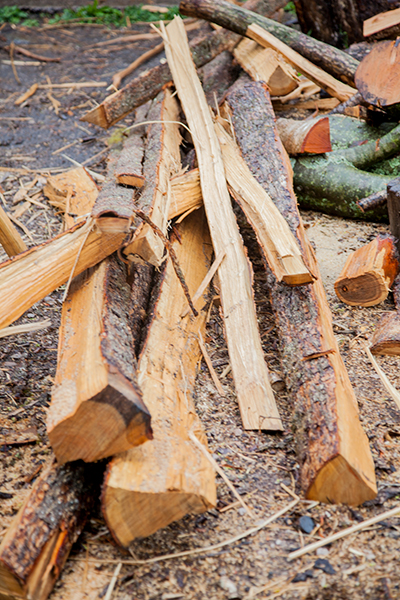
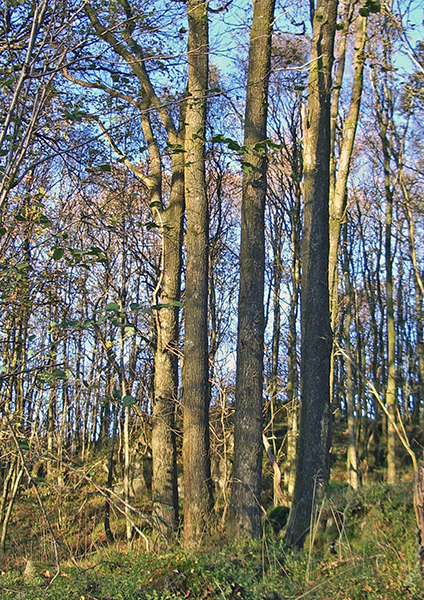
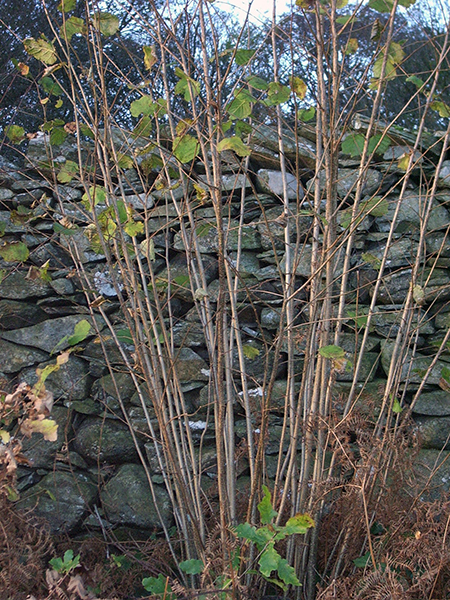
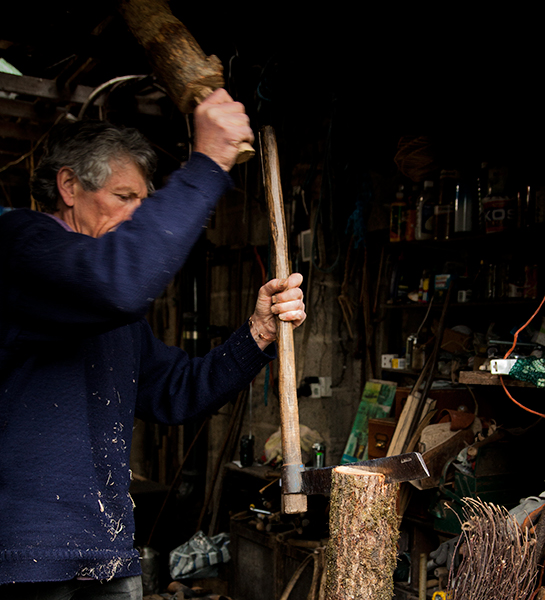
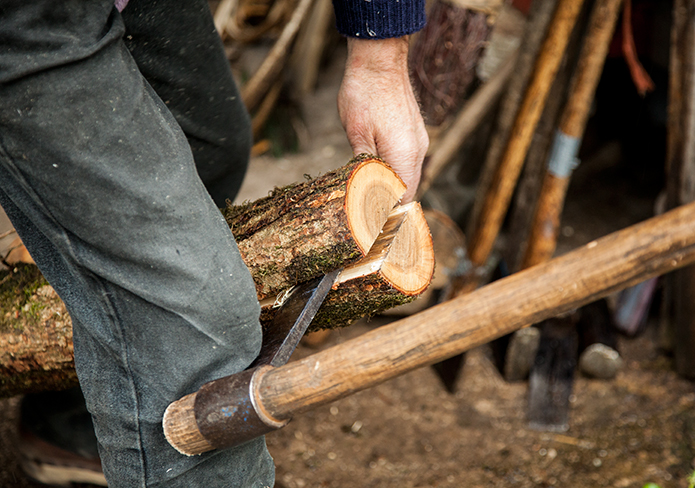
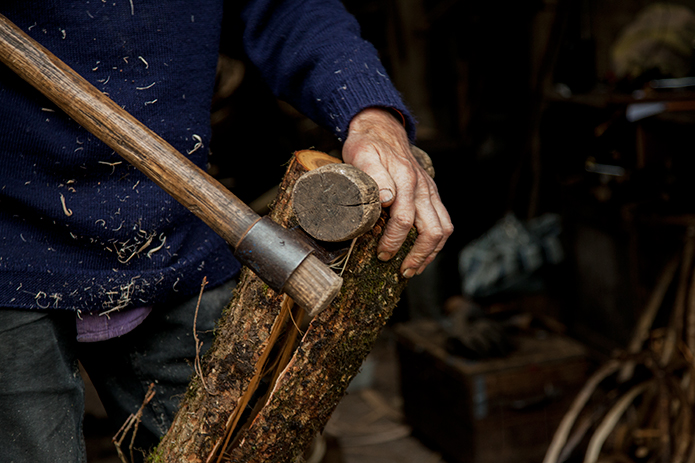
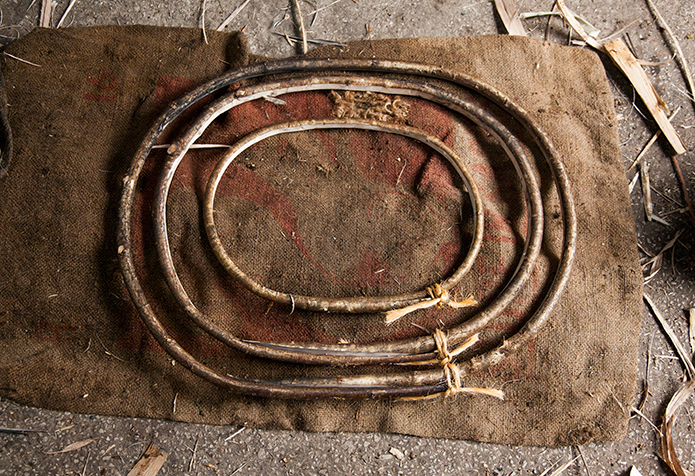
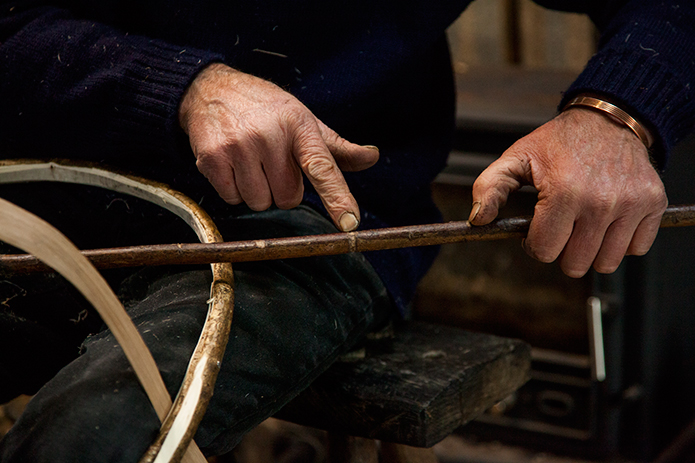
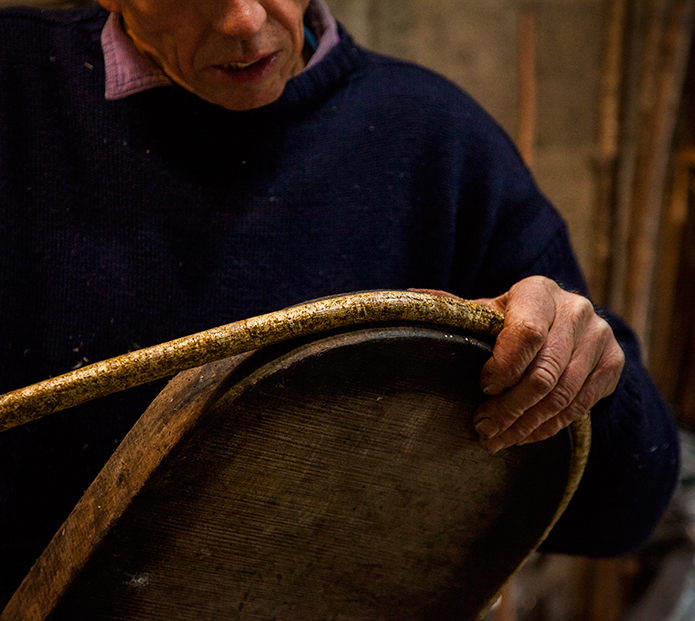
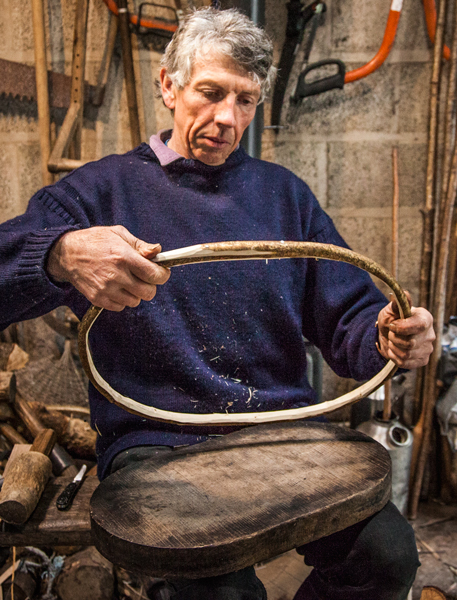
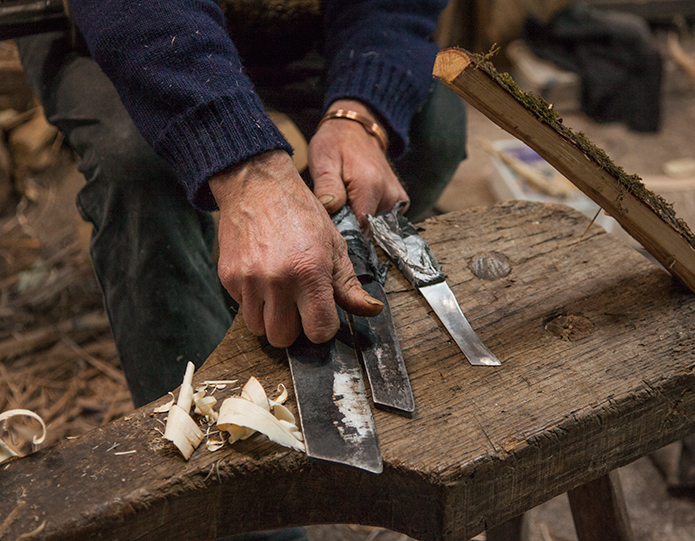
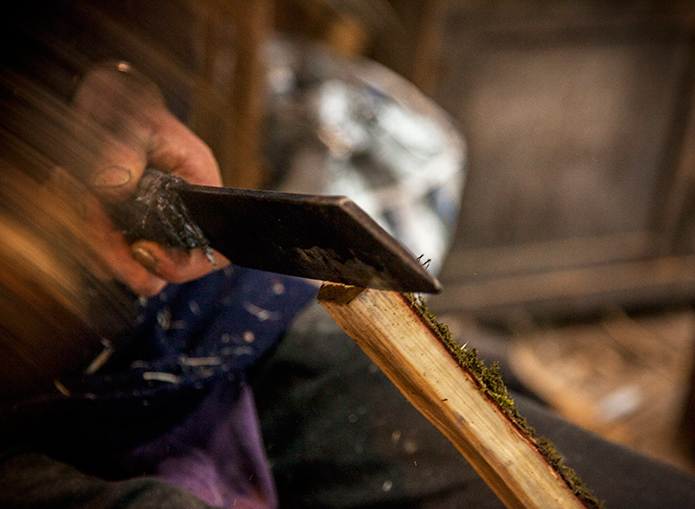
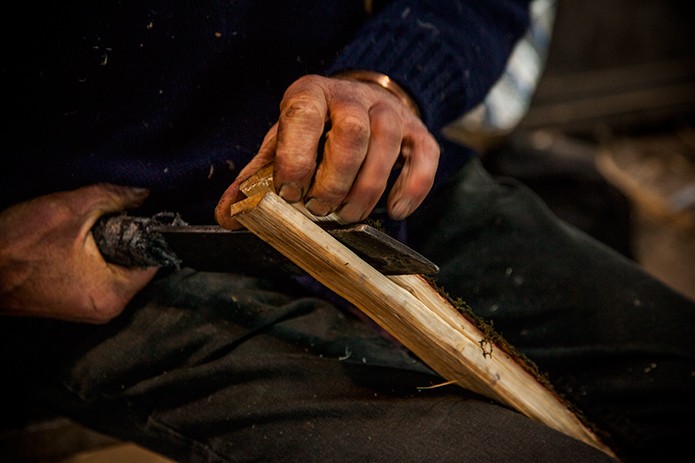
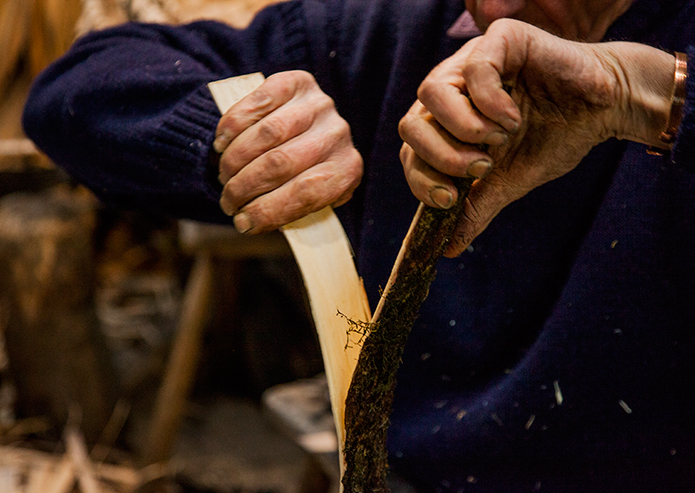
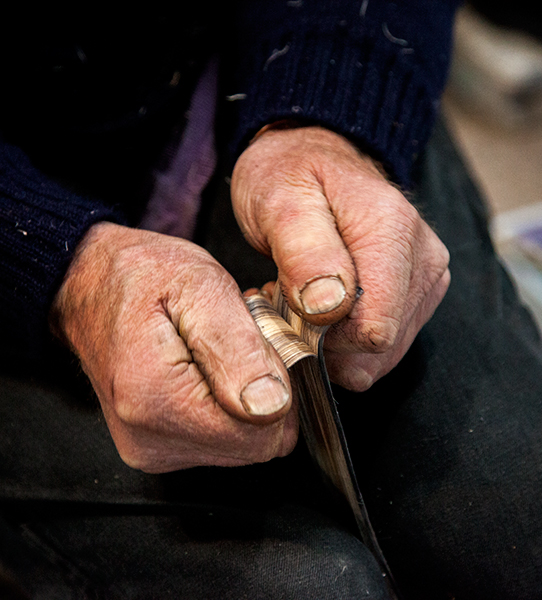
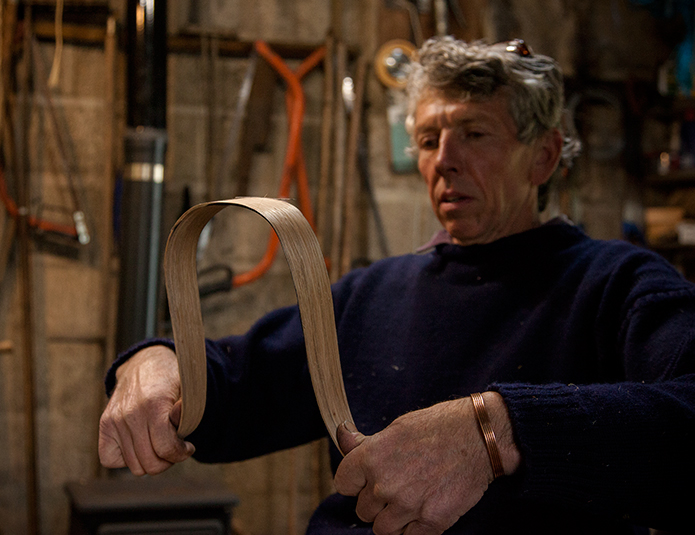
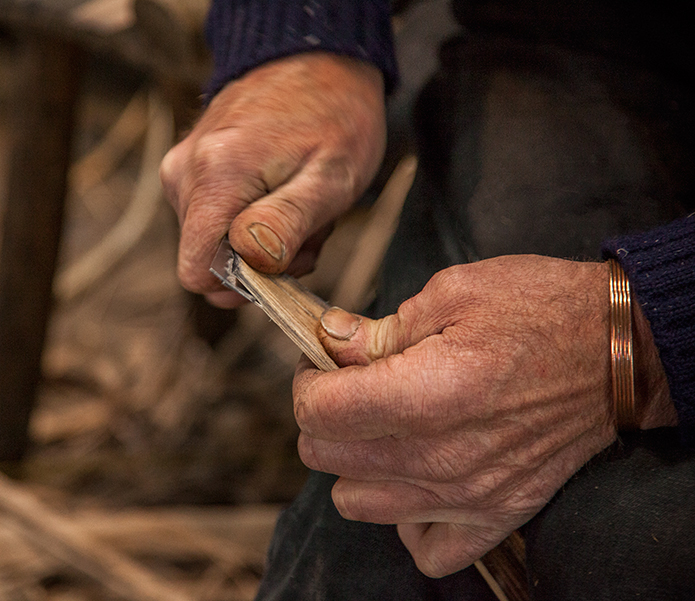
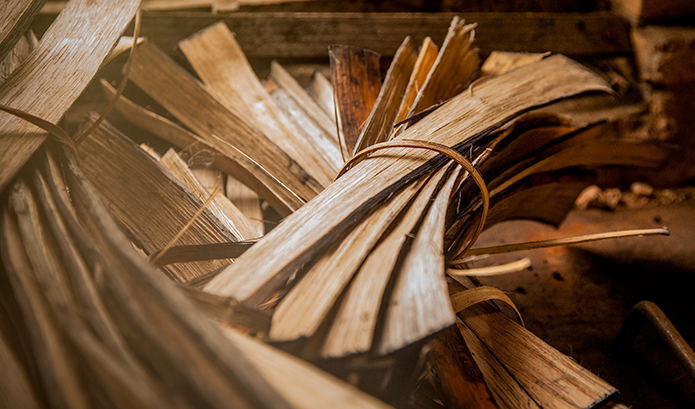
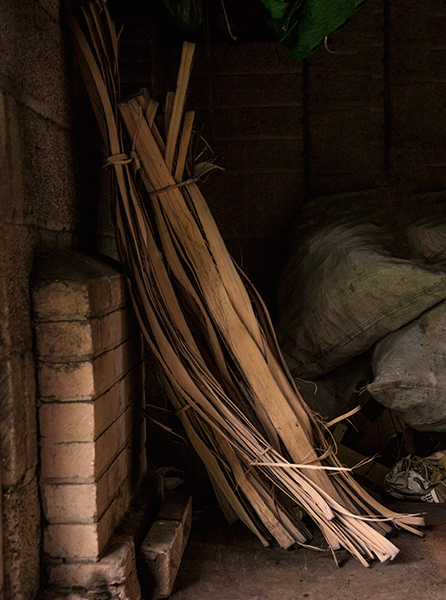
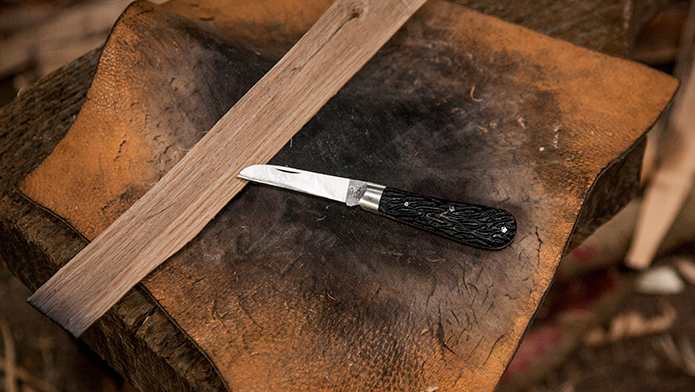
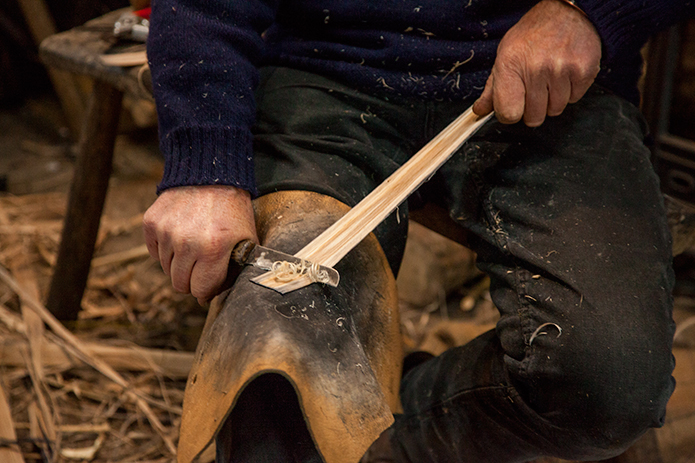
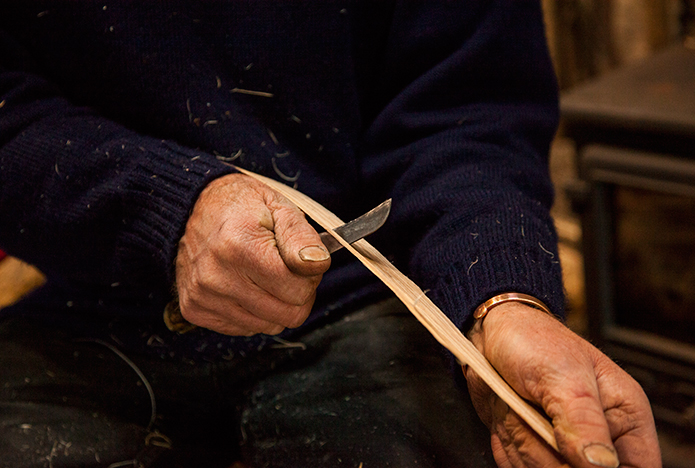
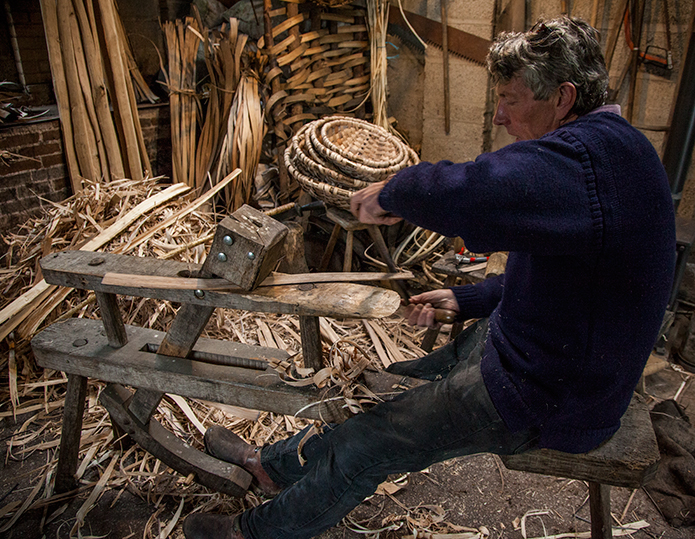
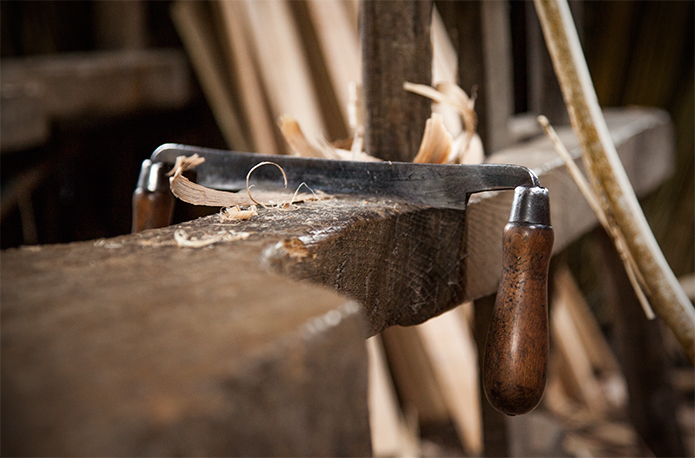
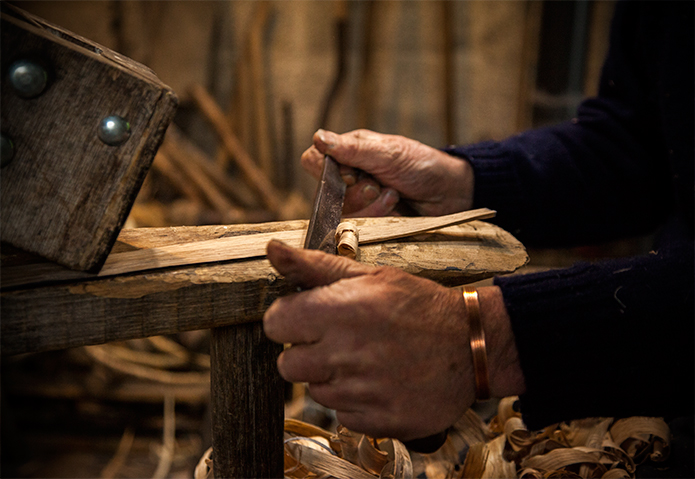
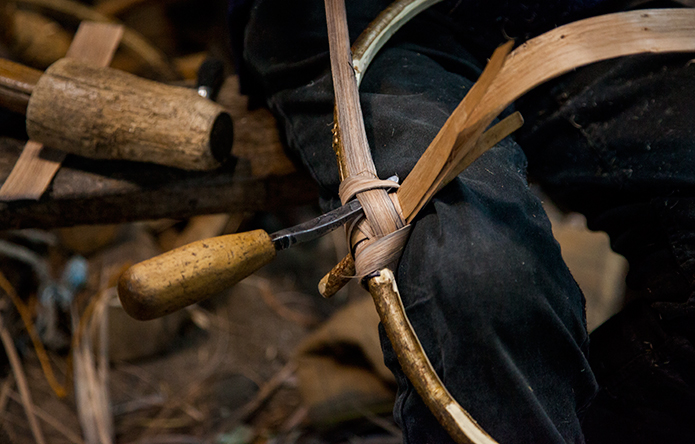
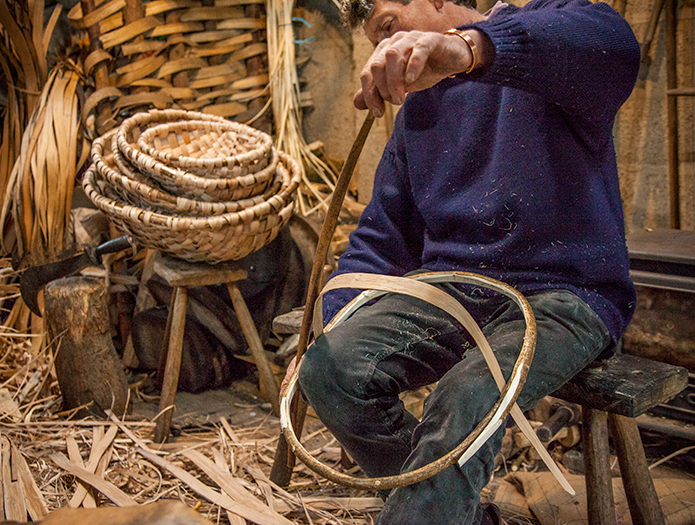

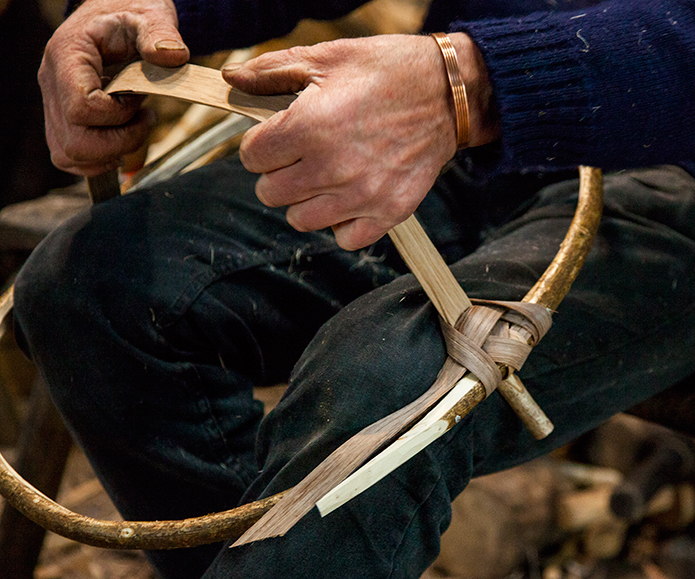
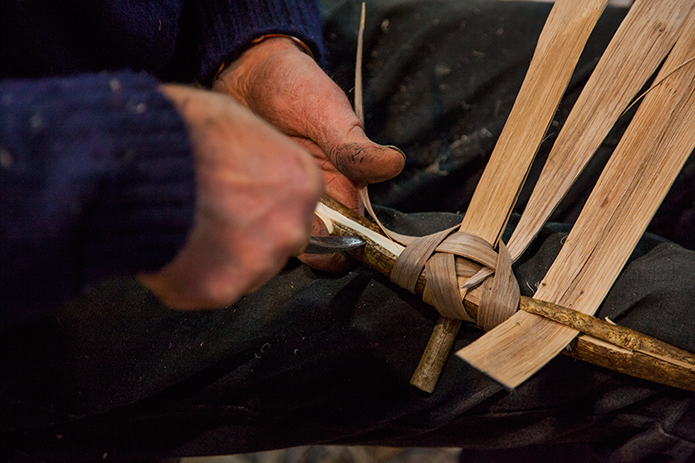
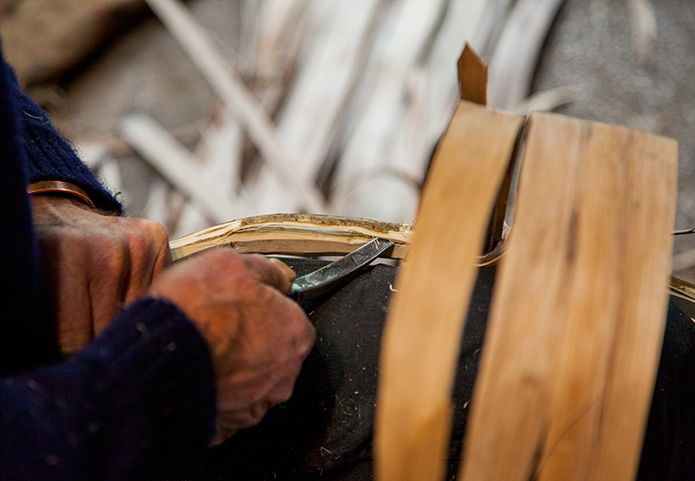
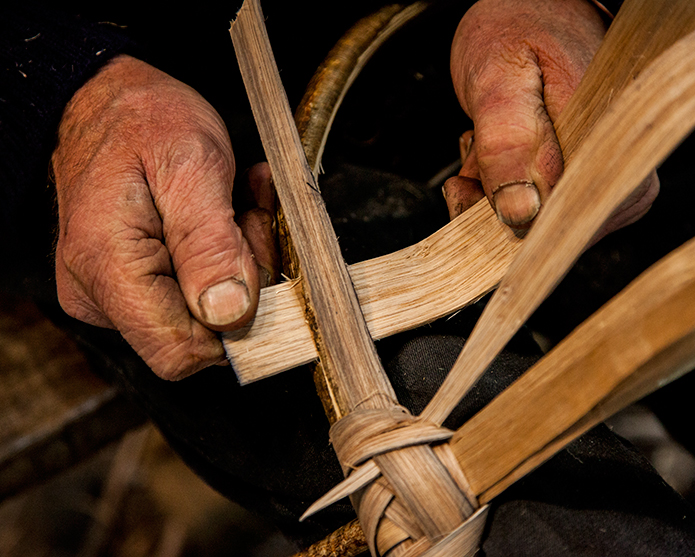
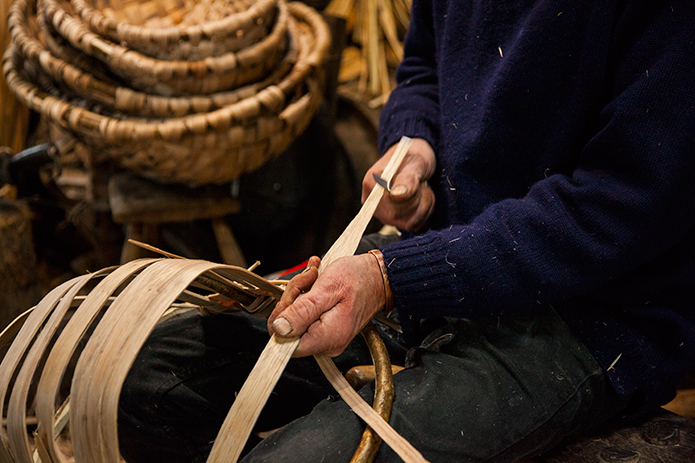
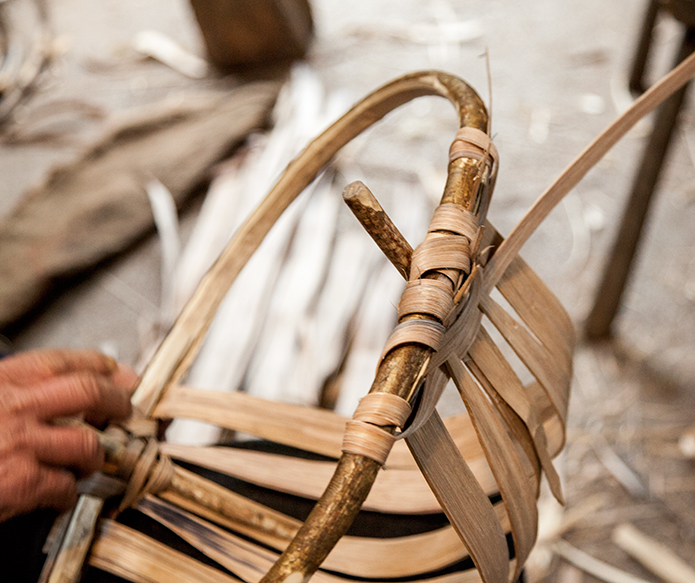
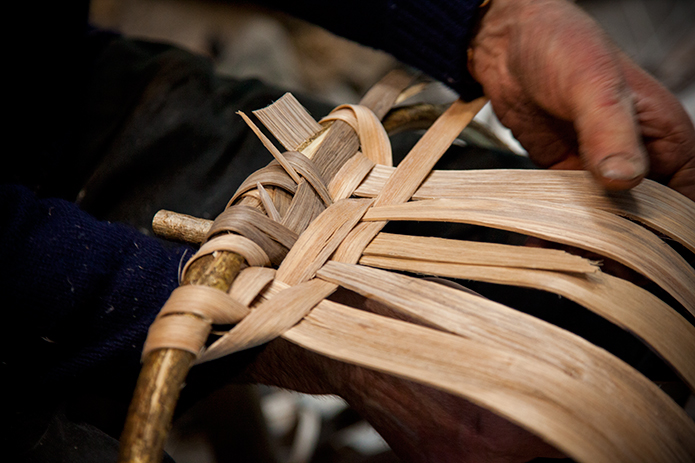
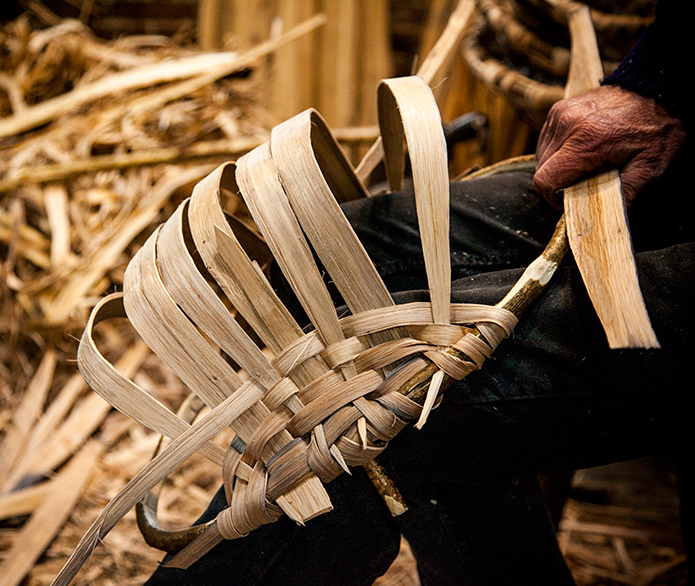
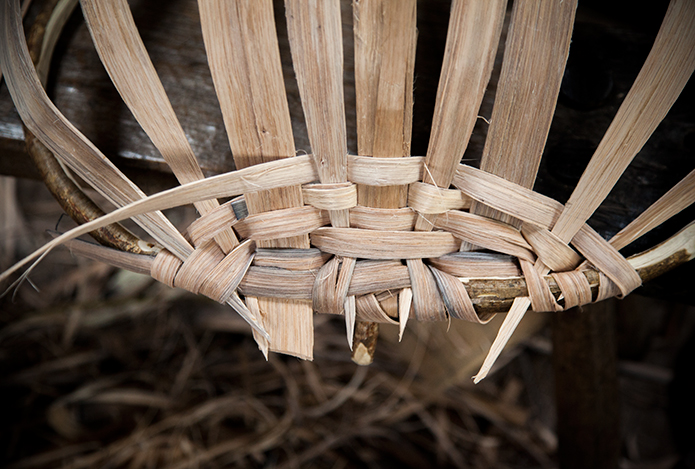
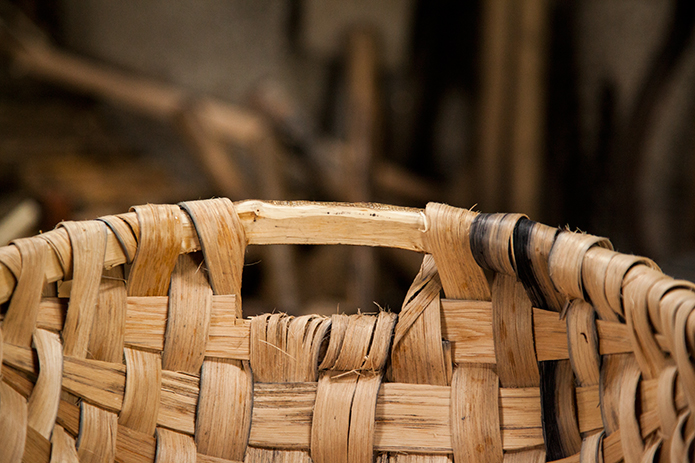
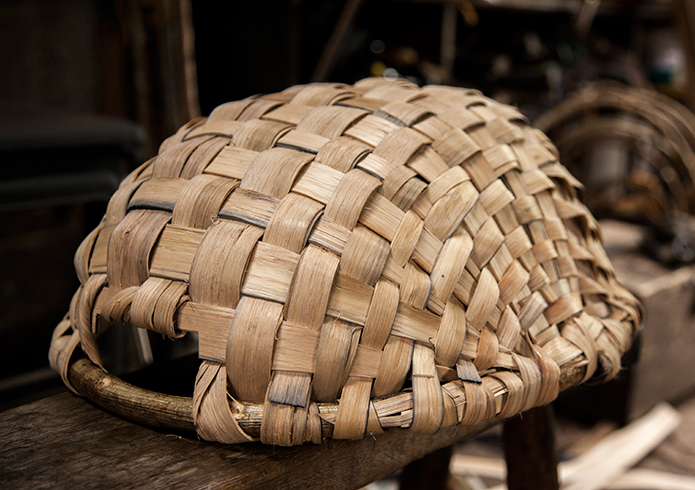
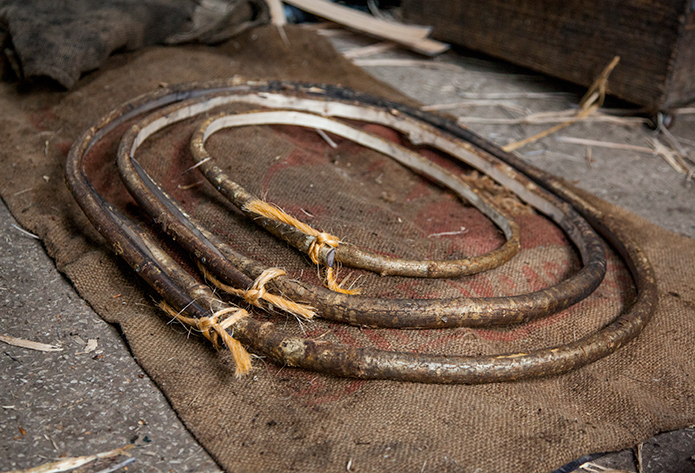
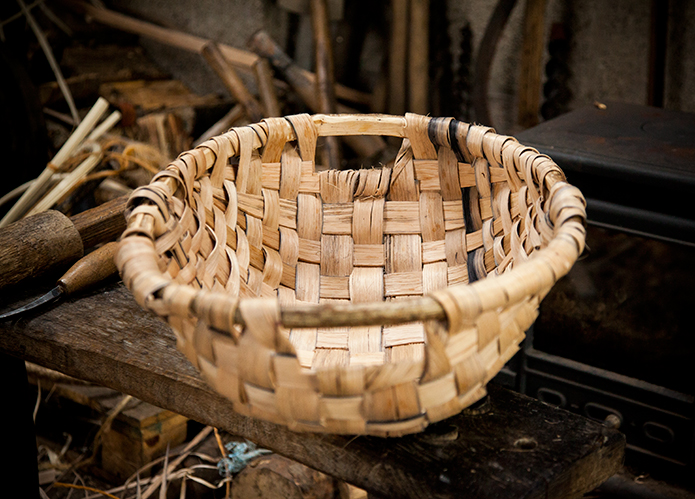









Tuesday, September 26th 2023 at 6:18 am
[…] basketryNE Basketmakers Guild lots of small topicsEnglish Basketry Willows – books for saleHow to make an oak swill basketPrairie Wood Basketry – resourcesApp – Baskets2dayWelsh Baskets – […]
Monday, March 1st 2021 at 9:59 pm
[…] someone who won’t be afraid to help get the chores done around the house or weave a basket (swiller was another word for basket […]
Monday, November 12th 2018 at 6:48 pm
[…] Thanks to Owen Jones for taking time out of his busy schedule to answer our questions. For our interview with Owen revealing the skill involved in making an oak swill, click here. […]